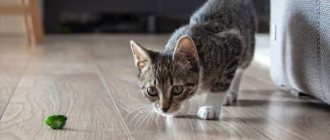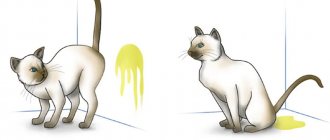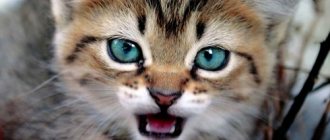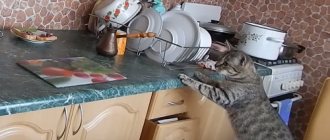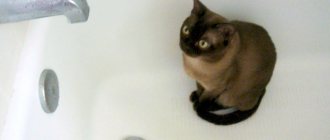Cats, like any living beings, have their own temperament, character, and disposition. Despite the fact that furry pets give us a lot of joy and positivity, some of the pranks of tailed pranksters cause a lot of trouble and inconvenience.
For example, pets can tear up furniture, carpets, tear off wallpaper from walls, chew indoor flowers, and shoes. Undoubtedly, bad habits need to be eradicated at an early age, since it is more difficult for adult animals to instill correct behavioral manners. To raise a well-mannered, obedient cat, you need time, patience, and the right approach. And in this article we will tell you how to stop a cat from jumping on walls and tearing wallpaper.
Why is the cat looking at the wall?
Almost every owner of a pet cat notices how their pet stares for a long time and carefully at the wall, as if he has found something very important and interesting for his eyes.
Many people wonder why the cat is looking at the wall. Moreover, the wall to which the pet’s attentive gaze is directed is often ordinary, there is nothing special in it for a person, without bulges and depressions, without spots and dots. Often a wall can become a place of attraction for inquisitive cat eyes for a very long time. Are there clear answers to this question? Undoubtedly. First of all, cats and cats are predators. Their main purpose in the house is to catch mice. And although our apartments do not have these rodent pests, feline animals never lose their natural instincts. For this reason, nothing can hide from their watchful eyes, neither day nor night.
Why are they doing that
Domestic cats are deprived of the pleasures that hunting brings them. The only way to diversify your leisure time is to try to steal something. Pet theft and acrobatic stunts can be justified by the desire to get what the owners do not give. You have to take risks, this process brings real pleasure to cats.
The aroma of victory calms cats: sleeping on the table or stealing food when the owners are not looking is very risky and entertaining. All cats love to climb high surfaces, so they choose an advantageous position for hunting. In the wild they use trees. The higher the cat is, the stronger its influence.
Feeling grateful, pets try to please their owners. If you find a gift from a furry prankster near your bed, rejoice at such care - he is not indifferent to you.
Facts and figures
A cat or cat that sits, seemingly relaxed, perfectly sees everything that is happening nearby and around. Then, everyone knows the fact that representatives of the cat world are well oriented in the dark, they see perfectly in the absence of at least some glimmer of light. By nature, cats are nocturnal predators. They need special vision at any time of the day for hunting, and the latter for survival. That's why nature bothered to give them everything they needed for this :
- Cats' vision is 6 times sharper than humans.
- Just as in the Russian song they sing “I recognize my dear one by his gait,” so a cat sees its owner 100 meters away.
- Thanks to the special convexity of the eyes, each meow is able to monitor what is happening around him within a radius of 190-270 degrees, which is 1.5-2 times the all-round visibility of a person.
- In the dark, the pupils of a cat's eyes dilate significantly, and the illumination of the retina increases tenfold.
- A cat and a cat can distinguish up to 50 flickers per second, which is 2 times the frame rate.
- Cats and cats have the same retinal photoreceptors - rods and cones - as in humans. But the ratio of the former is 25:1, while the latter is 4:1.
- Behind the retina of cats' eyes is the tapetum, a greenish-yellow reflective layer of cells that enhance vision.
- Plus, for successful hunting of cats in pitch darkness, not only their keen eyes are responsible, but also a very developed sense of smell, as well as all kinds of whiskers-navigators that detect the smallest vibrations in the air.
Some tips for choosing anti-vandal wallpaper
1. In houses with small residents, it is better to glue non-woven wallpaper, which should be covered with washable acrylic dyes.
2. For painted wallpaper, you should leave a small container (? 20 ml) with paint in reserve, which will be useful for eliminating deep damage.
3. Fiberglass and contract wallpaper are the best option for rooms with pets that sharpen their claws and like to climb vertical surfaces.
4. Non-woven or laminated options are suitable for the kitchen, since greasy stains will not “eat into” them and can be easily removed from the surface during cleaning.
5. For the bathroom and toilet, you should choose wallpaper with a moisture-resistant structure, especially the backing (base) layer.
Square and circle
When a cat looks closely at a wall that has not been subject to any changes by members of the household, this means that the wall has been “occupied” by a midge, or a mosquito, or a spider; a speck of dust, speck, fluff, etc. has settled on it. As a hunter, it is important for a cat to know “where the wind is blowing”, i.e. what it is. Plus, the meowing creature, as one of the most curious animals in the world, is interested in the development of this situation. Surely, the cat is wondering where this insect came from, and where it will go later. This wall is like Kazimir Malevich’s “Black Square” - a bright circle for a cat to think about.
And another answer: for the tailed purr, as one of the cleanest animals on Earth, it is important to know when the wall will shake off this disgrace, or when its owner will do so. The gaze of the pet speaks eloquently about this, even screams. A cat and a cat speak a similar language to people.
When a cat looks into the eyes of its owner, it means that the animal wants something: to understand the mood of its older brother, to catch the wave of his mood. And then, having figured out this moment for himself, he begins to say with his eyes what he needs - either a fun game, or a hearty meal, or change the water in the bowl, or the filler in the tray.
There are no exceptions
Now there are several finishing options:
- "vandal-proof wallpaper". This is what we call hot-stamped vinyl wallpaper these days. This is a very durable material and pussies do not like it because of the discomfort during sharpening;
- combined types. At the bottom of the wall, wall panels are installed, for example, 1 meter high. Above, you can already glue the usual paper versions;
- Using the same combined method, you can glue carpet in the lower part. This is an innovation in the field of renovation work, and many designers suggest finishing with carpet even on the ceiling;
- painting walls or covering with textured plaster. With this finish, no cat will be able to sharpen its claws.
Decorating the hallway with decorative stone
Wall or void
The process when a cat looks at a wall or in a corner is reminiscent of meditation. A cat's brain is the size of a walnut. And a cat thinks no less than ours, and also draws conclusions. But the instincts of the pet take over everything; he will look at the wall, since any point on it serves as a hypothetically moving object. And if she also moves her paws, then she is potential prey.
Also, a cat and a cat can stare into space for a long time. What is emptiness for humans is not always the case for cats. A tiny ray of light can play its game in space, or some small object casts a shadow, and it trembles. Or a light breath of wind blows crumbs across the floor, creating the effect of a living creature.
There is an opinion that cats are able to see brownies, ghosts, otherworldly entities, incorporeal creatures from a parallel world. The cat is an ancient animal that came to us from the distant past and preserved religious things from there. Anything is possible. No one can confirm this hypothesis, nor can anyone refute it, why a cat is the first to be let into a new house.
Caprice or illness
A cat can not only look at the wall, but also rest its head against it, while still growling and releasing its claws. The Internet is teeming with photos and videos of a tailed pet resting its head against a wall or corner. Looks funny. But in most cases, such behavior of a cat’s pet is a fairly serious signal of its ill health.
For example, in the absence of the owner, the cat jumps and runs around the house. Cat Kevin McCallister “home alone” can fall off a shelf and land on his paws, fail to fit into a kitchen corner on sharp turns and hit a corner, or get a huge slap on the head from an overturned hard object. Finally, the same wall can cause illness. The cat ran and hit his head against the wall with all his might.
A cat can complain of being unwell using “meow-meow”, but it won’t help, people don’t understand. When the animal runs into a wall, it complains of pain in the head. The wall is a cat's assistant - it tells the owner what is hurting his beloved cat.
A person often notices something similar behind himself. When he has a headache, he wants to push it against the wall. A hard wall seems to be able to drown out the pain in my head. In the case of a cat, the wall seems to scream that the family pet needs medical attention.
We recommend reading: Are Cat Worms Transmitted to People?
There was a situation when a cat fell out of a high-rise building window. He survived, they picked him up, carried him into the apartment and released him, he crawled to the wall and rested his head against it. At a veterinarian's appointment, the cat's owners learned that their pet had a concussion.
In addition to a concussion, the reasons for a cat running into a wall can be various poisonings, metabolic disorders, nervous shock, and worst of all, tumors of the brain or spinal cord . You definitely need to contact an experienced veterinarian and, when all the bad things are behind you, your pet will again enjoy life, watch its “cartoons” on the wall and gratefully purr fairy tales in the ear of its beloved owner.
A cat can not only look at the wall, but also rest its head against it, while still growling and releasing its claws. The Internet is teeming with photos and videos of a tailed pet resting its head against a wall or corner. Looks funny. But in most cases, such behavior of a cat’s pet is a fairly serious signal of its ill health.
Mischievous murki
Thanks to their jumping ability, energy and penchant for tricks, domestic cats easily master the “high levels” of a human home, including bookshelves, window sills and the top panels of household appliances. But sometimes the passion for heights and balancing act can take on harmful, destructive shades and then mustache-striped:
- hang on curtains and curtains;
- running on wall hangings;
- jumping up and tearing the wallpaper;
- scratch furniture and door frames.
Undoubtedly, the owner experiences dissatisfaction from such undertakings of the tailed pet, and the accumulating irritation eventually breaks out in screaming, assault and, perhaps, even expulsion of the cat from the house.
Why does the cat run around the apartment like crazy?
This article provides information to give you an idea of what you're dealing with in typical pet situations. In any case, you need to contact a veterinarian, since it is impossible to make a diagnosis in absentia.
The cat is running around the apartment and yelling, hiding why and what to do
There may be several reasons for this strange behavior - a desire to go to the toilet, you gave cat food to eat, perhaps the pet wants to go for a walk. Try to observe the animal to draw certain conclusions.
If the whole point is a walk, then let him out during these hours; the food can be changed to regular food. Well, doing something with the toilet is not easy, because predicting when you want to visit the toilet is not always easy.
Why does the cat run to the old apartment if we have moved?
Cats, just like people, have their own attachments and needs, and it is not at all surprising that they strive to go where they grew up. Ask the new owners not to give them anything to eat. In your new home, protect your pet with your affection and care, so adaptation will be much easier for him.
Why does the cat run around the apartment like a mad animal and get scared?
This behavior can mainly be observed in those cats that do not walk outside much. Such a manifestation is a kind of natural instinct. The animal, in a way, models the situation that could have happened if it had been in the wild. The frequency of this behavior depends, first of all, on the cat’s temperament.
Why does a cat run around the apartment at night?
The hunting instinct influences the fact that at night cats are more sensitive: they pay attention to all sounds, creaks, and smells. This is especially true for young individuals. Since behavior is determined by nature itself, doing something will not be easy.
The cat runs after its tail and growls at it for reasons
This cat behavior is not a cause for concern. The animal plays and trains. Thus, the hunting instinct is developed.
Why does a cat run and meow before going to the toilet?
This crazy behavior is understandable - physical activity is aimed at stimulating intestinal function, thus speeding up the bowel movement process. Not all pets go to the toilet calmly.
The cat runs away from the rat, what is the reason
Many owners may notice that the cat does not catch rats as expected, but runs away from them, but why does this happen? In this case, genes can take their toll. Not all pets are hunters by nature, and some simply never do it. Therefore, when a cat sees a rat, it takes it for danger and tries to hide.
Why does a cat run away from a person?
The reason why a cat can run away from a person is because he once scared her. In this case, the animal will avoid repeated contact in every possible way.
If a kitten runs around with its mouth open, is this normal and what to do?
If a kitten not only runs around with its mouth open, but also constantly breathes like that, then this may indicate the presence of some health problems. When running, he may breathe this way because he is tired or because he is thirsty. In the second case, it is enough to give water and time to rest; as for health problems, only a doctor can help here.
Why does a cat run in circles or sideways?
As practice shows, this condition occurs after a stroke. In order to avoid complications, it is recommended to take the animal to a veterinarian.
The cat is running like crazy, twitching its back, how to calm it down
Common fleas can provoke this condition. To eliminate them, it is enough to buy a special collar or drops. If you cannot cope with the problem on your own, visit a veterinarian.
Why does a cat run at your feet when a small child cries?
Many cats react very sensitively to children, they feel sorry when they cry, play with them when they are having fun. If you notice that the cat behaves this way, then you can conclude that he is also trying to distract and calm the baby.
Cats, just like people, have their own attachments and needs, and it is not at all surprising that they strive to go where they grew up. Ask the new owners not to give them anything to eat. In your new home, protect your pet with your affection and care, so adaptation will be much easier for him.
Claw manipulation
In case of failure with psychological correction, manipulations with the claws will help moderate the ardor of the tightrope walker cat:
- Regular haircut . The easiest way is to trim your cat's claws weekly using a special nail clipper from a pet store or suitable tools from a woman's manicure set. As a result of trimming the keratinized sharp tip, the hook-shaped shape of the claw-toe is lost, and the cat does not feel such a passionate desire to tear up the sofa, wallpaper or new curtains. Accustoming an animal to the procedure of trimming its claws is not so difficult, and its result will be increased safety measures when keeping several animals together or communicating with children (read more about how to trim a cat’s claws).
- Silicone cases . If the cat is energetic, wild and likes to use its claws, as is often the case with carriers of “street blood”, then it will need special “anti-scratch” pads in the form of curved silicone pads from the pet store. In addition to the covers for the claws, the kit includes glue, with which the protective caps are held in place for 2-3 months, and subsequently break off along with the keratinized tip of the claw. The gluing process itself is not particularly pleasant for the mustachios, but in the end they get used to this procedure and patiently endure it. The caps do not interfere with movement and are not dangerous to the health of the pet.
Expert advice on putting on caps. Animal lovers who appreciate all the advantages of these devices advise:
- It is more convenient to carry out the manipulation together: the owner holds the animal on his lap, talks affectionately and strokes it, and the assistant acts as a “cat manicurist”.
- A little glue from the tube drips into the case, which is immediately put on the claw and pressed well to seal it.
- The glue dries very quickly, and after 10 minutes the cat turns into a fashionable young lady with bright silicone claws that will not harm anyone or damage the apartment.
"Soft paw"
The fashion for “soft paws” in cats that came from overseas is actually a barbaric procedure to remove the terminal phalanges of the fingers along with the claws.
After this intervention, the claws no longer grow, but at the same time:
- the operated pet becomes less mobile and incapable of the famous feline tricks;
- there is a disturbance in the vestibular apparatus of the cat, and any fall from a height can be fatal;
- the animal is deprived of its natural protection and therefore becomes vulnerable, cowardly and unsure of itself;
- the cat loses its practical hunting skills.
Undoubtedly, the apartment interior is left untouched, but real cat lovers speak out against this operation, which distorts the natural feline physiology.
Can a cat yell for no reason?
In nature, stray cats do not use meowing to communicate with each other. Meowing is a cat's way of communicating with its owner. Cats of some breeds, for example, Siamese-Oriental Croup, Cornish Rex, Turkish Angora, have a habit of talking to their owners: when asked “How are you?” may respond with a loud “Meow.”
We recommend reading: Cost of Dog Ear Cropping
But these sounds cannot be compared with the loud screams that cats of these breeds, as well as those of the eastern group (Burmese, Bombay, Bengal, Ocicat, Egyptian Mau) emit during sexual heat. But this is only one, although the most common cause of screaming, and there are many of them, many of which are age-related.
Extreme measures
If water and tape don't work, it's time to move on to the big guns. The method can be considered a last resort, so it is better to resort to it after the previous points.
Pet stores sell special contact mats to stop cats from climbing on tables. The principle of operation is amazingly simple. As soon as a cat's paw touches the surface, that same paw is struck by a current discharge. The voltage in the device is small, so it won’t harm the animal’s health, but it can easily ruin his mood and turn the affectionate Barsik into a nervous furball.
If the need for weaning is more important than the moral state of the cat, you can buy a mat. It is better to do the weaning procedure under close supervision.
Why does a cat constantly meow?
Let's figure out why cats meow, keeping us awake.
A small kitten aged from birth to 3 weeks cries if:
What to do?
In order for the baby to calm down, it is necessary to warm it up to a normal temperature of 38°C, either by calling the mother cat, who abandoned the child for a long time, or by placing a bottle of warm water as a heating pad. After he warms up, you can feed him.
Older kittens scream for their mother in case of danger, any problem (got lost in a large apartment, felt lonely) or in pain due to accidental injuries.
In a new home, the kitten also calls the cat with a loud cry, in this case the only thing that can be done is to caress, warm, play - to let the cat child understand that he is not alone, he is loved and cared for.
If you do not plan for the kitten to have access to your bed, you need to teach him to spend the night alone from the first day, and therefore, in the first days, when the kitten is not yet accustomed to the new routine, you may have to endure some sleepless nights.
What to do if nothing helps?
If all efforts to re-educate a cat do not lead to the desired result, it makes sense to at least minimize the damage that its claws can cause. You can, for example, select materials for wall decoration taking into account their resistance to mechanical stress.
- Liquid wallpaper. This is a special mixture of cellulose that is applied to the surface like paint. It is inconvenient to tear up such decor.
- Fiberglass wallpaper. Made from glass fibers, they are durable and claw-resistant. The good thing is that they can be painted and washed many times. If anything, returning them to their original beautiful appearance will not be as difficult as if the walls were covered with paper wallpaper.
- Paintable wallpaper. It is better to choose smooth ones so that it is more difficult for the cat to catch them with his claw.
- Vinyl wallpapers. The likelihood that they will be able to withstand cat attacks for a long time is high. The solution could be even more elegant. Tiles are laid around the perimeter of the entire apartment or the lower part of the walls is trimmed with decorative stone.
Another not very pleasant way is to trim your pet’s claws. This can only be done with a special tool designed for cat “manicure”. If you do not have the skill to trim, it is advisable to entrust this matter to a veterinarian who knows exactly how to avoid damaging the blood vessel in the claw area. Although we cannot guarantee that this procedure will be successful. Some cats are so resistant to trimming their claws that it is almost impossible to do. But if the pet has passed the test, you should reward it with something tasty.
You can buy a scratching post or make one yourself. In theory, such a device should be in the house when the kitten is still small. It is easier to train him to sharpen his “sabers” on such an object. If the cat is an adult, it is not always possible to quickly show him all the benefits of a scratching post.
These items vary in appearance. A store-bought scratching post can be as simple as a flat box. But even if you wrap an ordinary log with a rope, this is already a useful thing for a cat. You can make such a device in the form of a column on which the tailed pet will comfortably hang, holding on to it with sharp claws.
In some houses, where there is a lot of free space, entire play complexes are created for pets. They include rugs, houses, beds, turrets that allow you to jump from one “top” to another or get from place to place using special transitions
Here the animals warm up, getting the opportunity to feel like predators to the fullest, relieve nervous tension, and, importantly, are far from the walls with wallpaper
You need to install the simplest “wallpaper lightning rod” in the place where attacks on the walls occur. When there are several such places, then more than one scratching post will be needed. If the cat always sleeps in a certain corner, the device should be placed nearby so that after waking up he will immediately “warm up” on it. Then he will not be tempted to look for another item for exercise
To start attracting attention to the scratching post, you can make it smell like catnip.
A cat who does not understand the principle of operation of a scratching post needs to be brought to it and clearly shown how to use it - take the pet’s paws with your hands, place them on the object and run over it several times so that the cat releases its claws. When an animal uses a thing correctly, it should be praised and given something tasty.
Screams of young cats and cats
Young, sexually mature, uncastrated cats begin their calls closer to spring - in February or March, calling for a partner. If you do not plan to get offspring from your animal, the easiest way to stop nocturnal yelling is to castrate your pet.
By doing this, you will only improve the quality of his life, eliminating possible negative consequences (pyometra in cats, territorial markings of cats), and lengthen his life.
Other causes of loud screaming may include:
- The desire to attract attention - this is how cats can beg for a treat, demand to open a closed door, demand to play.
- Anxious state - cats sense the approach of a natural disaster or weather change within a few days, and can scream to wake up their owners if there is a fire in the house or with neighbors.
- The struggle for dominance in a pride - if there are several cats in the house and more than one stud cat, a young cat can find out with an older one “who is boss” even without a fight, just loud screams.
- reacts to the behavior of their owners ; unfortunately, owners treat their pets adequately. If a cat is beaten or shouted at, then in response the cat may begin to show aggression towards the owner (pressed ears, raised fur on the spine, a heart-rending scream coupled with jumping sideways - indicate that the cat perceives the owner as an enemy, which must be driven away).
What to do ?
A distraction strategy can stop the night cries of a young animal that are not associated with a spring hormonal surge: keep the cat awake in the evening, amusing him and yourself with active play with running around and simulating hunting; before going to bed, feed him generously, preferably meat (it takes longer to digest).
If this does not help, you can use plant-based drops (Cat Bayun), the Feliway system, or other sedatives.
When getting a pet, you need to remember that it is easier to teach than to retrain. If you don’t want problems with a cat crying at night, teach your baby order from the first day in the house.
Anti-scratch
If for some reason there is no opportunity to purchase and place a gaming complex or scratching post, you can turn to anti-scratch products. Anti-scratch guards are silicone attachments for pets’ claws, made from special materials that, if they get into the pet’s stomach, do not harm it. The glue used for them is non-toxic and does not cause irritation if overcooked.
A large selection of all kinds of attachments will allow the owner to easily find the right option
Their low price (around 300-400 rubles per set) and ease of handling may appeal to many cat owners who practice grinding their claws on interior items. However, it is worth keeping in mind that different pets react differently to rubber attachments on their fingers. Some individuals quickly get used to the anti-scratches, some strive to tear them off with their teeth and eat them.
Read more about anti-scratch for cats and how to choose the right size on our portal.
The meowing of aging pets
Aging animals often behave like older people: they require increased attention, throw tantrums for any reason or without it.
The constant cry of an old cat may indicate:
- The desire to insist on one's own in case of refusal.
- Feeling lonely - the cat calls the owner and demands attention.
- Painful syndrome – aging cats often develop arthritis, causing joint pain during sudden movements and jumping, and other health problems.
Apart from medical problems, only increased attention and affection can help correct the behavior of an old cat.
Protective coatings
Prudent owners think in advance about how to protect walls, floors, and upholstery from scratches:
- Clean cats do not like sticky surfaces and will not touch them with their paws. Table legs, armrests, and edges of window sills are covered with double-sided tape. To protect against scratches, adhesive tapes are produced. Sticky Paws - they are invisible, adhere firmly to fabric surfaces, and do not leave marks.
- Upholstered furniture is covered with covers made of strong, scratch-resistant fabric; they are easier to clean and replace than a sofa or armchair.
- During repairs, the walls are covered with durable, smooth wallpaper: vinyl, paintable, liquid, fiberglass. The corners are covered with plastic panels; they are easier to replace than to re-glue the walls. Cats are not interested in decorative plaster, ceramic tiles, linoleum, or durable laminate.
- The areas where the cat is targeting are temporarily covered with aluminum foil: animals do not like smooth sliding surfaces. Cats do not like packaging film with air bubbles; their claws sink into it and get stuck.
Repellent sprays with a motion sensor have appeared on sale. When cats approach, they make a sound or release a stream of air or water. This remedy is not used for animals with unstable psyches.
Night screams
To avoid discomfort at night, get your pet accustomed to your daily routine.
Washing your cat in the evening during heat gives a good result: by wetting her fur before putting her to bed, you are guaranteed to sleep all night, since she will be busy putting herself in order and will have no time to scream.
However, this method is safe if the house is warm and there is no chance for the cat to catch a cold on the cold floor.
In any case, castration of the animal will get rid of night meowing.
Instincts of wild ancestors
Most members of the cat family are naturally endowed with the talents of steeplejack and acrobat. No matter what climate the kitty lives in, and no matter what size it is, the desire to climb to the top is firmly anchored in its instinctive behavior.
According to observations of naturalists:
- jaguars and leopards hide their prey among the tree foliage, managing to drag the entire antelope carcass there so they can slowly enjoy the feast. These spotted predators love to rest in trees, comfortably lounging in the fork of branches;
- a lynx, raised from a daytime rest by hunting dogs, climbs onto higher branches and tries to sit there in order to quietly return to the den “by the upper road”;
- Pallas's cat escapes from enemies on high rocky ledges;
- Cheetah cubs climb a tree trunk, but adult animals lose this ability due to blunt, non-retractable claws and can only jump to a relatively small height.
When to contact a veterinarian?
If a cat screams for no apparent reason while in one position, it means she has health problems that require consultation with a veterinarian.
If the cry is associated:
- with lameness;
- abdominal pain;
- bowel dysfunction;
- loss of appetite;
- vomiting;
- slight trembling;
- urination;
- If you have itchy ears, a trip to the vet may save your cat's life.
You can raise a purr only by persistent repetition of the lesson: they understand everything perfectly, and, having accepted the primacy of the owner, the cat will calmly follow the established rules.
Features of training kittens
The learning process for kittens is different due to their perceptual characteristics. Animals should not be punished for up to 3 months, as this may cause moral injury. Until this age, such measures are ineffective, since the pet simply does not understand what they want from him, and is quite ready to obey. It is strongly recommended to accustom babies to scratching posts and reinforce the habit with praise and treats. The use of noise and water traps is strictly prohibited. They can injure the animal and cause behavioral disorders.
It is not recommended to give kittens old furniture instead of scratching posts. A grown-up pet will sooner or later begin to damage other property. The cat will think that since that old sofa could be scratched, then there is nothing wrong with it scratching the new chair. If the kitten has already been allowed to scratch furniture, then it is necessary to wean it off the bad habit completely, that is, those things that replaced the scratching posts should also be removed.
How to stop a cat from jumping on walls?
I have a British cat (8 months old) who jumps on the walls and tears up the wallpaper. I don't know how to wean him off this. He sharpens his claws on everything: furniture, walls. We bought a claw hammer, but he doesn’t accept it. What to do? please advise.
Provide your cat with as many opportunities as possible for movement and “acrobatics” - all kinds of play complexes - bought in a store or made with your own hands - will seriously entertain your cat for a long time - it will be much more pleasant for him to climb up a pipe wrapped in hemp rope than to tear wallpaper. Cats love to move and jump a lot. Aboriginal breeds such as the Kuril Bobtail also dive into the water for fish, and in an apartment, within four walls, cats are very bored, hence the jumping on the walls and striping the wallpaper.
I have a British cat (8 months old) who jumps on the walls and tears up the wallpaper. I don't know how to wean him off this. He sharpens his claws on everything: furniture, walls. We bought a claw hammer, but he doesn’t accept it. What to do? please advise.
Scented repeller
A cat's nose is the strongest indicator of odors. It can capture aroma in just a few molecules. And strong and intrusive odors act like an explosion on animals.
To stop your cat from visiting the table, it is enough to “scent” the tabletop with unpleasant odors for your pet:
- You can rub the surface with a piece of lemon or orange. The method is effective, but the scent will have to be updated periodically.
- Natural aromatic oils. It is enough to saturate the fabric with them and leave it on the table. No cat will go into the danger zone. However, it is worth choosing pleasant options so as not to wean your household away from the table.
- Oil burner. A good way to wean your pet and at the same time transform the atmosphere in the house. The same aromatic oils are poured into the lamp, a drop of water is added and the candle is lit. A floral train will turn the table into a real cat's nightmare.
How to stop a cat from jumping on walls
Good afternoon. The cat constantly jumps on the door frames and rips off the wallpaper. She used to jump on flowers, but we sprinkled pepper on them and she stopped. and you can’t put pepper on the walls. Does anyone know how to stop her from jumping on walls? I tore up all the jambs and the wallpaper too. It's a pity that the renovation was only recently done
We recommend reading: The Largest American Cat
Woman.ru experts
Find out the opinion of an expert on your topic
Kachkacheva Maria Mikhailovna
Psychologist. Specialist from the site b17.ru
Fedor Erokhin
Psychologist, Arranger Clinical psychologist. Specialist from the site b17.ru
Olga Samokhvalova
Psychologist, Emotional-imaginative therapy. Specialist from the site b17.ru
Yakovleva Oksana Aleksandrovna
Psychologist, Consultant. Specialist from the site b17.ru
Maksimov Sergey Vyacheslavovich
Psychologist, Online consultant. Specialist from the site b17.ru
Spiridonova Nadezhda Viktorovna
Psychologist. Specialist from the site b17.ru
Zubkova Anna Andreevna
Psychologist, Gestalt therapist. Specialist from the site b17.ru
Nevzorova Sofya Igorevna
Psychologist. Specialist from the site b17.ru
Tsvetaeva Lara Alexandrovna
Psychologist, Online consultant. Specialist from the site b17.ru
Unexpected fall
The method is somewhat inhumane, but one session may be enough for the cat to forget the way to the table. To carry out the plan, you will need a lightweight plastic tray.
The tabletop is furnished with “inconvenient” objects so that only one side remains free. Bottles and pots will come in handy as an impromptu fence. Place the tray on the free side, pushing it slightly beyond the edge of the tabletop. You can pour some water into the tray itself.
Further events can be predicted. The cat doesn't want to jump on the tray, but there is no choice, because the whole table is occupied. The animal jumps, knocking over the tray. Water pours onto the cat, and the container itself falls to the floor with a crash.
Folk remedies
The most popular folk remedy is vinegar. It is diluted in a 1:1 ratio and the area where the animal shits is washed. It not only removes unpleasant odors, but also repels the pet. Some people prefer to use bleach or bleach. But, firstly, not all mustaches are repelled by this smell. Secondly, for people living in an apartment, frequent use of bleach is unlikely to be beneficial, especially for children.
A weak solution of potassium permanganate, iodine solution (a few drops per liter of water), and hydrogen peroxide are suitable for disinfection. A paste of baking soda and water removes odor well, and after drying it can be easily swept up or removed with a vacuum cleaner.

